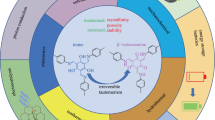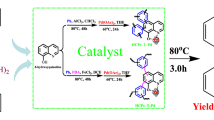Abstract
An azobenzene (AZO)-bridged cubic silsesquioxane network exhibiting reversible photoisomerization behavior in nonpolar solvents has been prepared via hydrosilylation reaction between 4,4′-diallyloxy-azobenzene and octahydridosilsesquioxane (H8Si8O12; H-POSS). Approximately 70 % of the corner Si–H groups of H-POSS are reacted to form a three-dimensional gel network while maintaining the cubic siloxane structure. The dried gel has a high thermal stability, which is attributed to the highly cross-linked cubic silsesquioxane network where AZOs are covalently incorporated in the main chain. The gel exhibits reversible swelling behavior in nonpolar solvents during wetting–drying cycles. In toluene, a large extent of reversible trans–cis isomerization of the AZO moiety is observed. These results are promising for the design of a new class of photoresponsive materials applicable in host–guest chemistry.
Graphical Abstract









Similar content being viewed by others
References
Sanchez C, Julián B, Belleville P, Popall M (2005) Applications of hybrid organic–inorganic nanocomposites. J Mater Chem 15:3559–3592
Hu LC, Shea KJ (2011) Organo–silica hybrid functional nanomaterials: How do organic bridging groups and silsesquioxane moieties work hand-in-hand? Chem Soc Rev 40:688–695
Ruiz-Hitzky E, Aranda P, Dardera M, Ogawa M (2011) Hybrid and biohybrid silicate based materials: molecular vs. block-assembling bottom–up processes. Chem Soc Rev 40:801–828
Orgiu E, Samor P (2014) 25th Anniversary article: organic electronics marries photochromism: generation of multifunctional interfaces, materials, and devices. Adv Mater 26:1827–1845
Tanaka T, Ogino H, Iwamoto M (2007) Photochange in pore diameters of azobenzene-planted mesoporous silica materials. Langmuir 23:11417–11420
Alvaro M, Benitez M, Das D, Garcia H, Peris E (2005) Reversible porosity changes in photoresponsive azobenzene-containing periodic mesoporous silicas. Chem Mater 17:4958–4964
Besson E, Mehdi A, Lerner DA, Reyé C, Corriu RJP (2005) Photoresponsive ordered hybrid materials containing a bridged azobenzene group. J Mater Chem 15:803–809
Guo S, Sugawara-Narutaki A, Okubo T, Shimojima A (2013) Synthesis of ordered photoresponsive azobenzene–siloxane hybrids by self-assembly. J. Mater. Chem. C 1:6989–6995
Guo S, Chaikittisilp W, Okubo T, Shimojima A (2014) Azobenzene–siloxane hybrids with lamellar structures from bridge-type alkoxysilyl precursors. RSC Adv. 4:25319–25325
Guo S, Matsukawa K, Miyata T, Okubo T, Kuroda K, Shimojima A (2015) Photoinduced bending of self-assembled azobenzene–siloxane hybrid. J Am Chem Soc 137:15434–15440
Tanaka K, Chujo Y (2012) Advanced functional materials based on polyhedral oligomeric silsesquioxane (POSS). J Mater Chem 22:1733–1746
Xiao S, Nguyen M, Gong X, Cao Y, Wu H, Moses D, Heeger AJ (2003) Stabilization of semiconducting polymers with silsesquixane. Adv Funct Mater 13:25–29
Joshi M, Butola BS (2004) Polymeric nanocomposites–polyhedral oligomeric silsesquioxanes (POSS) as hybrid nanofiller. J. Macromol. Sci. Part C 44(4):389–410
Chaikittisilp W, Sugawara A, Shimojima A, Okubo T (2010) Hybrid porous materials with high surface area derived from bromophenylethenyl-functionalized cubic siloxane-based building units. Chem Eur J 16:6006–6014
Chaikittisilp W, Sugawara A, Shimojima A, Okubo T (2010) Microporous hybrid polymer with a certain crystallinity built from functionalized cubic siloxane cages as a singular building Unit. Chem Mater 22:4841–4843
Jiang C, Yang W, Li L, Hou Y, Zhao X, Liu H (2015) An efficient approach to octabromophenylethyl functionalized cage silsesquioxane and its use in constructing hybrid porous materials. Eur J Inorg Chem 3835–3842
Wang S, Tan L, Zhang C, Hussain I, Tan B (2015) Novel POSS-based organic–inorganic hybrid porous materials by low cost strategies. J. Mater. Chem. A 3:6542–6548
Lo MY, Zhen C, Lauters M, Jabbour GE, Sellinger A (2007) Organic-inorganic hybrids based on pyrene functionalized octavinylsilsesquioxane cores for application in OLEDs. J Am Chem Soc 129:5808–5809
Zhu YK, Guang SY, Su XY, Xu HY, Liu XY (2013) Highly efficient and stable solid-state luminescent nanohybrids: precise architecture and enhancement mechanism. J Mater Res 28:1061–1069
Chi H, Mya KY, Lin T, He C, Wang F, Chin WS (2013) Thermally stable azobenzene dyes through hybridization with POSS. N J. Chem. 37:735–742
Liu Y, Yang W, Liu H (2015) Azobenzene-functionalized cage silsesquioxanes as inorganic–organic hybrid, photoresponsive, nanoscale, building blocks. Chem Eur J 21:4731–4738
Bialecka-Florjanczyk E, Soltysiak JT (2011) Synthesis and characterization of liquid crystalline silsesquioxanes containing azobenzene groups. Mol Cryst Liq Cryst 548:28–36
Ledin PA, Tkachenko IM, Xu W, Choi I, Shevchenko V, Tsukruk VV (2014) Star-shaped molecules with polyhedral oligomeric silsesquioxane core and azobenzene dye arms. Langmuir 30:8856–8865
Ledin PA, Russell M, Geldmeier JA, Tkachenko IM, Mahmoud MA, Shevchenko VM, El-Sayed A, Tsukruk VV (2015) Light-responsive plasmonic arrays consisting of silver nanocubes and a photoisomerizable matrix. ACS Appl. Mater. Interfaces 7:4902–4912
Miniewicz A, Girones J, Karpinski P, Mossety-Leszczak B, Galina H, Dutkiewicz M (2014) Photochromic and nonlinear optical properties of azo-functionalized POSS nanoparticles dispersed in nematic liquid crystals. J. Mater. Chem. C 2:432–440
Miniewicz A, Tomkowicz M, Karpinski P, Sznitko L, Mossety-Leszczak B, Dutkiewicz M (2015) Light sensitive polymer obtained by dispersion of azo-functionalized POSS nanoparticles. Chem Phys 456:65–72
Su X, Guang S, Xu H, Yang J, Song Y (2010) The preparation and optical limiting properties of POSS-based molecular hybrid functional materials. Dyes Pigments 87:69–75
Zhou J, Zhao Y, Yu K, Zhou X, Xie X (2011) Synthesis, thermal stability and photoresponsive behaviors of azobenzene-tethered polyhedral oligomeric silsesquioxanes. N J. Chem. 35:2781–2792
Su X, Guang S, Xu H, Liu X, Li S, Wang X, Deng Y, Wang P (2009) Controllable preparation and optical limiting properties of POSS-based functional hybrid nanocomposites with different molecular architectures. Macromolecules 42:8969–8976
Huang J, Huang Y, He C, Gao Y (2015) Synthesis and characterization of photoresponsive POSS-based polymers and their switchable water and oil wettability on cotton fabric. RSC Adv. 5:100339–100346
Wang XT, Yang YK, Yang ZF, Zhou XP, Liao YG, Lv CC, Chang FC, Xie XL (2010) Thermal properties and liquid crystallinity of side-chain azobenzene copolymer containing pendant polyhedral oligomeric silsequioxanes. J Therm Anal Calorim 102:739–744
Wang X, Yang Y, Gao P, Yang F, Shen H, Gao H, Wu D (2015) Synthesis, self-assembly, and photoresponsive behavior of tadpole-shaped azobenzene polymers. ACS Macro. Lett. 4:1321–1326
Agaskar PA (1991) New synthetic route to the hydridospherosiloxanes Oh-H8Si8O12 and D5 h-H10Si10O15. Inorg Chem 30:2707–2708
Zhou G, Smid J (1991) Hydrosilylation of m-TMI: new siloxane based aliphatic polyisocyanates. J Polym Sci, Part A: Polym Chem 29:1097–1105
Carniato F, Bisio C, Gatti G, Boccaleri E, Bertinetti L, Coluccia S, Monticelli O, Marchese L (2009) Titanosilsesquioxanes embedded in synthetic clay as a hybrid material for polymer science. Angew Chem Int Ed 48:6059–6061
Choi J, Harcup J, Yee AF, Zhu Q, Laine RM (2001) Organic/inorganic hybrid composites from cubic silsesquioxanes. J Am Chem Soc 123:11420–11430
Deng Y, Li Y, Wang X (2006) Colloidal sphere formation, H-aggregation, and photoresponsive properties of an amphiphilic random copolymer bearing branched azo side chains. Macromolecules 39:6590–6598
Yi Q, Sukhorukov GB (2014) UV-induced disruption of microcapsules with azobenzene groups. Soft Matter 10:1384–1391
Shankar BV, Patnaik A (2006) J-aggregates in matrix stabilized two-dimensional azobenzene derivatives. J Colloid Interface Sci 302:259–266
Haruta O, Matsuo Y, Ijiro K (2008) Photo-induced fluorescence emission enhancement of azobenzene thin films. Colloids Surfaces A: Physicochem. Eng. Aspects 313–314:595–599
Bandara HMD, Burdette SC (2012) Photoisomerization in different classes of azobenzene. Chem Soc Rev 41:1809–1825
Ichimura K (2015) Photoisomerisation of azobenzene crystals in aqueous dispersions examined by higher order derivative spectra. Phys Chem Chem Phys 17:2722–2733
Ichimura K, Nagano S (2014) Individual photoreorientation of non-aggregated and aggregated azobenzene side chains tethered to a liquid-crystalline polymer determined by higher order derivative spectra. RSC Adv. 4:52379–52383
Moitra N, Kanamori K, Shimada T, Takeda K, Ikuhara YH, Gao X, Nakanishi K (2013) Synthesis of hierarchically porous hydrogen silsesquioxane monoliths and embedding of metal nanoparticles by on-site reduction. Adv Funct Mater 23:2714–2722
Acknowledgments
This work was supported in part by a Grant-in-Aid for Scientific Research on Innovative Areas ‘New Polymeric Materials Based on Element-Blocks (No. 2401)’ provided by The Ministry of Education, Culture, Sports, Science, and Technology, Japan.
Author information
Authors and Affiliations
Corresponding author
Electronic supplementary material
Below is the link to the electronic supplementary material.
Rights and permissions
About this article
Cite this article
Guo, S., Okubo, T., Kuroda, K. et al. A photoresponsive azobenzene-bridged cubic silsesquioxane network. J Sol-Gel Sci Technol 79, 262–269 (2016). https://doi.org/10.1007/s10971-016-4074-4
Received:
Accepted:
Published:
Issue Date:
DOI: https://doi.org/10.1007/s10971-016-4074-4




